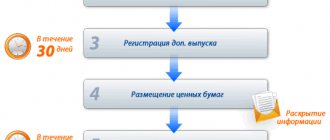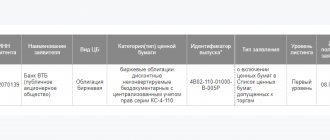In English, the word LIST is translated as “list,” which reflects the essence of this concept: listing, in fact, implies that securities are included in the list of available instruments; without inclusion in a special list, a security cannot be traded.
In simple words, listing on an exchange is the addition of a company’s securities to one of the lists of a specific exchange platform, which makes them available for trading.
Before being added to the list, certain actions are carried out (submitting an application, verification, registration, etc.), but the essence of the concept lies precisely in the appearance of shares/bonds in the lists of instruments.
The concept of “listing” is found in various areas of life and implies certain differences in the interpretation of definitions.
Listing in different areas:
- On stock/cryptocurrency exchanges – means adding securities/cryptocoins to the lists of exchange platforms.
- Listing in trade - adding products of a certain manufacturer to the store’s assortment.
- In real estate, listing agreements are signed between the property owner and the sales agent who sells for a commission.
- In programming, the source code of a program, which is interpreted into executable code using a compiler.
Traders often think that listing is the list of instruments on the site itself, but it is more correct, after all, to consider the term to denote all stages of the procedure for adding to this list (and not just the final result). Typically, the initiator of the listing is the company itself, but sometimes, due to high demand for securities among traders, the exchange may also offer to carry out the procedure.
The listing procedure provides a lot of benefits to companies, so this issue is important for many enterprises. Listing should not be confused with IPO - these are different concepts: listing involves going through a procedure in order to get listed on a specific exchange, IPO is turning a company public, after which its securities become available to investors through any platforms and channels.
Concept
Studying the listing, what it is in simple words is quite simple to explain when the stock markets are considered.
We are talking about the procedure for admitting securities for free circulation and trading on a specific platform. After listing, shares, bonds, mortgage certificates, investment shares, depository receipts are included in the exchange quotation list. Important components of the listing procedure:
- All formalities and procedures prior to the inclusion of securities in the quotation list.
- Monitoring the compliance of all investment instruments with the requirements existing on the exchange.
Listing is carried out in relation to any issuer that applies to the exchange. Thus, securities of companies that meet certain requirements regarding financial performance, risks, liquidity, etc. are carefully selected for trading. This is a kind of regime for admitting securities to be included in the quotation list of the site.
To a certain extent, listing is a filter that cuts out unsuitable companies and non-compliance with the set conditions. Those companies that have undergone the procedure increase their rating in the eyes of consumers/investors.
The main advantages provided by listing securities:
- The issuer finds itself in the visibility zone of large investors, confirms its financial performance and serious intentions.
- Investors can see which companies have been vetted and can find the securities they need from different lists.
- The stock exchange manages to expand the range of instruments - it also benefits from listing different issuers.
General requirements for two listing levels
The general requirements are:
- Securities must be issued and registered in accordance with the requirements of the legislation of the Russian Federation and other regulatory documents.
- The report on the results of the monetary issue of securities must be registered in the prescribed manner.
- Securities must be freely tradable.
- Availability of quotes from at least two market makers in the trading system on an ongoing basis.
- For shares of joint-stock companies: interested parties should own no more than sixty percent of the voting shares of the joint-stock company.
- Issuers of securities must unconditionally accept obligations to comply with the requirements established by law and the stock exchange for disclosure of information in a certain manner and volume.
Rules
All rules and requirements are approved by the stock exchange. Conditions may vary between sites, but in general terms they are usually similar. So, as an example, we can consider the listing procedure of the MICEX (Moscow Exchange). In this case, all securities are admitted to trading through listing; the decision is made only by the Moscow Exchange.
The MICEX list consists of 3 sections/levels: first, second, third. The listing level is determined based on the characteristics of the company’s activities, financial indicators and other conditions.
Required conditions for listing:
- Compliance of all areas of the company’s activities with legal norms.
- Acceptance by the issuing company of the obligation to disclose all necessary information.
- Prospectus registration.
- Service at the Settlement Depository.
The full version of the rules and conditions is always available on the official website of the exchange (at the MICEX, for example, in the “Documents” section).
Benefits for the company
The advantages that a company has by being listed on the stock market are that
- reliability increases and trust on the part of all market participants increases;
- public fame and popularity;
- wide access to relatively cheap sources of financial resources;
- very high (and even potentially unlimited) opportunities to attract additional financial resources for the effective development of the company;
- increased growth of the company's capitalization due to increased demand and prices for its securities;
- high liquidity of securities issued by the issuer;
- in some cases, receiving special tax benefits.
Process steps
To better understand what listing is, it is worth considering the stages of this procedure.
Usually it includes several main points, without which it is impossible to get on the list. Main stages of the listing procedure:
- The issuer or intermediary submits an application about the desire to place securities on the stock exchange (this is pre-listing).
- An agreement is signed on the implementation of an expert assessment by exchange specialists.
- The issuer submits a package of documents necessary for the examination - reports, balance sheets and others.
- Carrying out an examination of bonds and shares that apply for inclusion in the list.
Performing an assessment of the issuer's activities - studying the main macroeconomic indicators (the amount of authorized capital, liquidity, profitability, etc.).- The results of the work are reviewed by the quotation commission (the Central Bank inspection commission) within 10 days, then a decision is made regarding the inclusion of the issuer in the quotation list (this may take more than a month). Usually the entire procedure takes up to 2 months.
It happens that an examination reveals a company’s non-compliance with the requirements of the exchange. Then the securities can be included in the pre-listing (preliminary register), warning investors against risky investments.
Based on this, it can be argued that listings become a confirmation of the reliability of the security and the stability of its performance and financial performance. Pre-listed securities can be bought/sold, just outside the exchange where they have not been verified.
What does listing give to the issuer:
- Increasing capital by attracting investor money.
- The company's appearance in various ratings.
- Access to world trading exchanges.
- Increasing interest in the issuer on the part of investors.
- The ability to “quickly” sell securities at a price close to the market price.
After the listing takes place and the securities appear on the trading platform, this does not mean that this will always be the case. Under certain conditions, the exchange may delete securities due to the issuer's non-compliance with the conditions, failure to fulfill obligations, or low price of the securities. When merging enterprises, the company itself can initiate delisting (exclusion of a security from the list).
List of securities admitted to trading
Let's look at the List of securities admitted to trading on the Moscow Exchange.
In total, as of March 1, 2021, there were 2,749 securities traded on the Moscow Exchange from 714 issuers. Of them:
- shares – 264;
- bonds – 1,970, including Eurobonds, OFZ, corporate and municipal;
- foreign instruments – 321.
In the 1st column we see different listing levels. There are three of them in total, the 1st and 2nd are combined into the quotation list, the 3rd is not included in it. To assign a particular level to an instrument, the following are taken into account:
- compliance with the requirements of the legislation of the Russian Federation;
- registration of a securities prospectus;
- the issuer's assumption of the obligation to disclose information about its activities, financial position, etc.;
- financial condition, reputation and reliability of the issuer;
- interest from potential investors;
- circumstances giving reason to believe that the rights and interests of investors may be violated.
These are general settings. There are nuances in assigning certain types of instruments (shares, bonds, shares) to different levels. We will consider them separately. The most reliable assets are included in the quotation list. The requirements for inclusion in the 3rd level are much more flexible than for the first two. Securities that apply to be included there only need to fulfill the first three conditions described above.
More than 100 cool lessons, tests and exercises for brain development
Start developing
The list includes the following information for each security:
- The type of quotation list level, the date of inclusion in it, or an indication that the securities are not included in the quotation list.
- Issuer's name.
- Type of securities.
- Issue registration number and registration date.
- Number and date of registration of trust management rules.
- International Identification Number (ISIN) and International Classification of Financial Instruments (CFI).
- The nominal value and the currency in which it is expressed.
- Facts of default.
Criteria and requirements for issuers
An issuer may be included in one of three lists, each of which meets certain requirements. All of them are based on and correlate with the current legislation of the Russian Federation. A securities prospectus must be registered, information must be disclosed, and securities must be accepted for service in the settlement depository.
Requirements for different levels:
- Corporate governance standards are for 1/2 levels, not necessary for the third.
- The duration of the company's existence is at least 3 years for the first and 1 year for the second; the third level does not require requirements.
- The period for opening IFRS reporting before inclusion in the list - the first level requires 3 years, the second year and the third have no requirements.
Conditions for free-float (share of shares in free float), their price and capitalization of the issuer in general: for the first level, capitalization for joint-stock companies (ordinary shares) is at least 60 billion rubles and free-float is at least 10% with a market value of at least 3 billion rubles , for preferred shares free-float minimum 50% and capitalization 1 billion rubles. The second level does not impose capitalization requirements, but free-float is at least 10% with a market price of 1 billion rubles for JSC, AP assumes 50% free-float and a minimum value of 500 million rubles.- Turnover - the first level assumes the daily average volume of transactions with the Central Bank for the quarter is at least 1 billion rubles, and the total number of days with the conclusion of transactions is at least 70% per quarter (the requirement is canceled if there are 2 agreements with market makers on the security), the second and third level of rules do not install.
If the established requirements are met and after the listing has been carried out, securities can move from the lowest list to the highest. If the requirements are violated, the level is lowered accordingly. It happens that the exchange allocates time for the issuer to correct shortcomings.
Different exchanges and countries may have their own additional requirements. Many international companies want to be listed on different exchanges. But the issuer is officially registered in one country, while in another the shares can be deposited with a professional participant and depository receipts can be issued. You can trade in another country, but you need to look at the conditions and specific requirements.
Features of Russian listing
All over the world, companies undergoing the listing process receive a number of undeniable benefits for shareholders and, as a result, for themselves. The main advantage is to improve the company's image and increase the liquidity of securities, as well as to significantly expand the circle of shareholders, including large institutional investors. For Russian companies that have undergone the listing procedure in Russia, there is an opportunity to attract the most conservative investment community - Russian and foreign institutional investors. Management companies are allowed to invest pension savings only in securities that are included in the stock exchange quotation lists.
In Russia, investing in listed securities provides additional opportunities that allow investors to seamlessly and effectively implement a variety of investment strategies.
Of course, the main requirement is timely disclosure of information, market capitalization and the number of shares in free float, as well as mandatory compliance with a number of standards of corporate conduct.
Quotation lists and levels
After the listing procedure is completed successfully, issuers are included in the lists. But this does not mean that they are equivalent to one another. Thus, oil securities cannot be compared in weight to the securities of the industrial metallurgical and mining holding Mechel PJSC. And the point is not that the second company is worse or less reliable (if it had been so, the listing would not have been completed), but the importance of the shares is different.
To make it easier for investors to find the right instrument, stock exchanges divide all securities into three levels. Each level has its own quotation list. The first level includes the largest issuers (blue chips on the MICEX, for example, including Gazprom, Novatek, Sberbank, Rosneft, etc.). The second level includes second-tier companies that cannot be called blue chips (for example, Megafon, Rosseti, Polyus, etc.).
The third level unites companies of the third/fourth echelons (such as Detsky Mir, AvtoVAZ, Unipro, Mostotrest, etc.). As the level decreases, liquidity decreases—that is, there are fewer investors working with issuers.
Typically, the trading turnover with the first level is small and funds are invested in such companies for long-term investment (they are not relevant for intraday/medium-term trading).
Listing - information from Wikipedia
However, listing as a phenomenon has found application for everyday tasks. For example, in order not to keep a large number of different tasks or assignments in your head, for convenience you can “outline” the so-called “to-do list” - a list of current affairs. You can also create a “check list” - that is, a readiness sheet that indicates the basic requirements or criteria for a successfully implemented project. In production, a note sheet or “snagging list” is often used, which allows you to analyze breakdowns and make suggestions for correcting them.
Classification and types
Listing can be primary or secondary. The primary is carried out to begin circulation of the Central Bank within the Russian exchange market. All companies traded on the MICEX took part in just such a listing. If the issuer wants to enter international platforms, it undergoes a secondary listing and gains access to be placed on foreign exchanges - New York, London, etc.
Domestic regulations allow secondary listing only for companies that have completed the primary procedure. Conditions for secondary listing are more flexible, the procedure takes less time. The issuer's securities, for which the procedure is performed on foreign exchanges, influences the choice of terminology.
Types of secondary listing:
- Direct listing (aka Direct listing) - is carried out to register an issuing company in another country where it is planned to trade securities on exchanges.
- Depository receipts (aka Depository Receipts) – only depository receipts of the issuer can be traded on foreign exchanges.
- Dual listing - double listing involves sequentially obtaining access by the issuer's central bank to several different exchanges in one country. This increases the liquidity of shares.
- Cross-listing – cross-listing is a one-time/cross access to securities on several exchanges, helps to reduce financial and time costs.
What are the benefits for investors?
Buying shares is a popular type of investment. Almost anyone with any income level can become a shareholder. The cost of one security is not so high even for very well-known companies.
Example, share price of well-known companies (as of March 25, 2019):
McDonald's (Nyse exchange) – 185 USD;
Apple (Nasdaq) – 188 USD;
Boeing (Nyse exchange) – 370 USD;
Gazprom (Moscow Stock Exchange) – 152 RUB (about 2.4 dollars);
BMW (ETR) – 69 EUR;
Sony (Tokyo Stock Exchange) – 4,630 JPY (about 42 US dollars);
Samsung Electronics (Korea Exchange) – 45,500 KRW (about 40 US dollars).
Practice shows that shares of successful companies that have been operating on the market for a long time only increase in price over time. They are subject to fluctuations in the short term, but in the long term they often give profit.
For some investors, buying shares is an investment for the long term, a replacement for a bank deposit or pension account. For others, it is important to make a profit in the short term from exchange rate fluctuations. Whatever option the investor chooses, in order to invest their savings with maximum reliability, a certain level of knowledge and the right choice of the company through which the transaction will be carried out are required.
The most important thing that listing gives investors is the confidence that the reliability of the company chosen for investment has been verified by professionals.
Listing to IPO ratio
Sometimes these two concepts are confused, but they are not identical. IPO is an Initial Public Offering, the first public offering of shares of the issuing company on the stock exchange. Listing is one of the stages of an IPO - in order to be able to trade its instruments on a specific exchange, the issuer needs to go through the listing procedure and only after that be placed.
Listing, therefore, is a mandatory procedure for including securities on the list of those traded on a particular exchange. Without listing, the stock exchange will not release shares or bonds for trading. An IPO is an initial public offering of securities on the market, this is the very fact of issuing shares and bonds for their sale (“production of a product”), and listing is the procedure for adding an instrument to the lists for sale on the stock exchange (“delivery to a store”).
Listing is an integral stage of putting up a company’s securities for trading, so you need to take the fulfillment of all the requirements of the exchange platform and the procedure itself as seriously as possible.
Listing Objectives
Therefore, it is safe to say that the purpose of the listing is:
- firstly, creating favorable conditions for trading on the stock exchange, as well as increasing investors’ awareness of the state of the securities market, and of course, identifying the highest quality and most reliable securities,
- and secondly, protecting the interests of investors and increasing their confidence in securities, as well as creating uniform rules of examination for the admission and circulation of securities.
Differences when carried out in different countries
Despite the fact that the main criteria for adding assets to stock exchange lists in different countries of the world are the same, there are some differences, both in the procedure itself and in the criteria for candidates.
Firstly, the timing may vary (already described above).
Secondly, there are differences between the profit margin requirements of an organization. For example, the New York Stock Exchange expects the issuer's profit for the last year to be at least $18 million, while the Tokyo Stock Exchange is considering candidates with profits of $3.7 million (400 million yen).
What additional information to read about listing on the world's largest stock exchanges
Conditions for listing on the Tokyo Stock Exchange Conditions for listing shares on the SSE - Shanghai Stock Exchange requirements for listing on the TSX - Toronto Stock Exchange Why do corporations need a listing on the NYSE? What does ]listing on the Frankfurt Stock Exchange[/anchor] give? NASDAQ: the No. 2 exchange in the world through the eyes of Masterforex-V traders How to get on the main listing of the London Stock Exchange?
What it is?
Listing (from the English listing) is a set of procedures for including the issuer’s assets in the exchange list admitted to trading, as well as monitoring their compliance with the norms and rules established by the platform. Upon completion of expert actions on documents and inclusion of shares in the quotation register, they are considered to have passed the event.
The sequence of the procedure for passing listing events consists of a number of approved stages:
- Submission of an application by the issuer or a professional consultant representing its interests.
- Registration of an application and examination of the established standard by the exchange. The stock is analyzed for volume and duration of circulation. In addition, it is important to assess the company’s activities in terms of profitability, liquidity and capital flow.
- Providing the required documentation package. To access the exchange, the company provides documents, the set and completeness of which depend on the type of asset and level of listing. The main documents are represented by audited financial statements for the last 3 years and the approved prospectus. Preparing documentation and bringing the organization to the appropriate standards requires financial and time investments.
- Analysis of assessments received from experts. The meeting of the commission for the admission of assets determines the liquidity, initial placement cost, projected demand and investment attractiveness of the shares.
Each exchange has its own requirements for the economic parameters of the issuing enterprise.
Pros and cons of listing
Once a company has successfully completed listing, it will receive a whole list of benefits:
- First of all, the degree of trust in the company in the eyes of investors will increase.
- There will be more sources of funding.
- Demand for shares will increase and, as a result, capitalization will increase.
- With more funding, the company will be able to grow.
- In some cases, the company will be able to receive tax benefits.
- Privileges during credit transactions.
If we talk about the disadvantages of listing, issuers highlight the following disadvantages:
- The current value of the company's assets is affected by any market changes - both negative and positive.
- Listing is not a free procedure. The company will have to pay a certain amount every year.










